You read that correctly. Bucks are done growing! Whatever you see on the top of their head now is what will be there in the fall.
No more, no less.
But it’s only July. They are still covered in velvet. Hard antlers aren’t seen until September.
All those things are true but so is the fact that those antlers still covered in velvet are no longer getting bigger. Why? Remember that antler tissue is the fastest growing tissue known to man. To grow at this remarkable rate, the cartilage matrix is highly vascularized so blood can transport the nutrients needed. Antlers are bone. Which means this cartilage matrix needs to calcify. That takes time. About a month’s time to be exact.
Antlers, like trees, grow from the tip (not the base) and it takes about 160 to 170 days to complete antler growth. As the summer progresses and day length begins to decrease, testosterone production increases. This triggers mineralization or hardening of the antlers. The soft tissue is transformed directly into bone by the depositing of minerals within the cartilage matrix through that extensive capillary network hardening the antlers from the base to the tip.
Antler-hardening takes about a month starting in mid-July and ending in mid-August.

Velvet, the fuzzy covering on growing antlers, stays on until the antlers are completely hardened. Blood flow is interrupted then and the tissue dies. Dead and dry, the velvet is rubbed off.
Because of the velvet covering (12 hair filaments per square millimeter, each 5 millimeters long), antlers appear larger than the “finished” product.
So that monster buck you’ve been watching all summer may shrink a bit come the fall.
Either way, what you see on a buck’s head right now is what you’ll get come September…minus the velvet of course.
-Jeannine Fleegle, biologist
PGC Deer and Elk Section
If you would like to receive email alerts of new blog posts, subscribe here.
And Follow us on Twitter @WTDresearch
